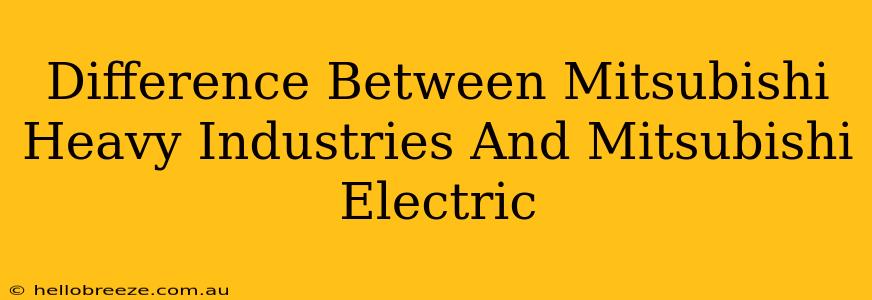The names "Mitsubishi Heavy Industries" (MHI) and "Mitsubishi Electric" (MELCO) might sound similar, and their logos share a familiar three-diamond emblem. However, these are distinct companies with separate histories, focuses, and business operations. Understanding their differences is crucial for anyone working in or researching the global manufacturing and technology sectors.
Distinct Histories, Separate Paths
While both companies trace their roots back to the Mitsubishi group, their modern identities diverged long ago. Their separation wasn't a clean break but rather a gradual evolution of specialized expertise.
Mitsubishi Heavy Industries (MHI): A Legacy in Heavy Industry
MHI boasts a rich history deeply entwined with heavy industrial manufacturing. From shipbuilding and aircraft manufacturing to power generation and industrial machinery, MHI's contributions are monumental. Think large-scale projects: building massive ships, designing advanced aircraft, and providing critical infrastructure solutions. Their expertise spans:
- Energy: Power plants (nuclear, thermal, and renewable), energy storage solutions.
- Industrial Machinery: Machinery for manufacturing, infrastructure, and logistics.
- Aerospace: Aircraft manufacturing, space exploration technologies.
- Infrastructure: Construction and engineering of bridges, buildings, and other large-scale projects.
- Shipbuilding: Designing and building commercial and specialized vessels.
Mitsubishi Electric (MELCO): The Electronics Giant
MELCO, on the other hand, focuses primarily on electrical and electronic products. Their reach extends across various consumer and industrial sectors, with a strong emphasis on technology and innovation. Their product lines include:
- Consumer Electronics: Home appliances, televisions, audio equipment.
- Industrial Automation: Robotics, factory automation systems, and industrial control solutions.
- Power Electronics: Power transmission and distribution equipment, inverters, and related technologies.
- Semiconductors: Design and manufacturing of various semiconductor components.
- Information and Communication Technology (ICT): Network solutions, telecommunications equipment.
Key Differences Summarized
The following table highlights the core distinctions between MHI and MELCO:
| Feature | Mitsubishi Heavy Industries (MHI) | Mitsubishi Electric (MELCO) |
|---|---|---|
| Primary Focus | Heavy industry, large-scale infrastructure projects | Electronics, electrical systems, and related technologies |
| Products/Services | Ships, aircraft, power plants, industrial machinery | Consumer electronics, industrial automation, semiconductors |
| Market Positioning | Provider of large-scale infrastructure and industrial solutions | Provider of electronics, automation, and ICT solutions |
| Typical Projects | Building nuclear power plants, manufacturing aircraft carriers | Developing advanced robotics, designing next-generation semiconductors |
The Mitsubishi Legacy: Shared Values, Separate Identities
Despite their separate paths, both MHI and MELCO maintain a strong commitment to quality, innovation, and global competitiveness. The Mitsubishi legacy serves as a common thread, underscoring a history of technological advancement and industrial leadership. However, understanding their individual focuses allows for a clearer understanding of their respective contributions to the global marketplace. They are not interchangeable and cater to distinct sectors within a diverse industrial landscape.

